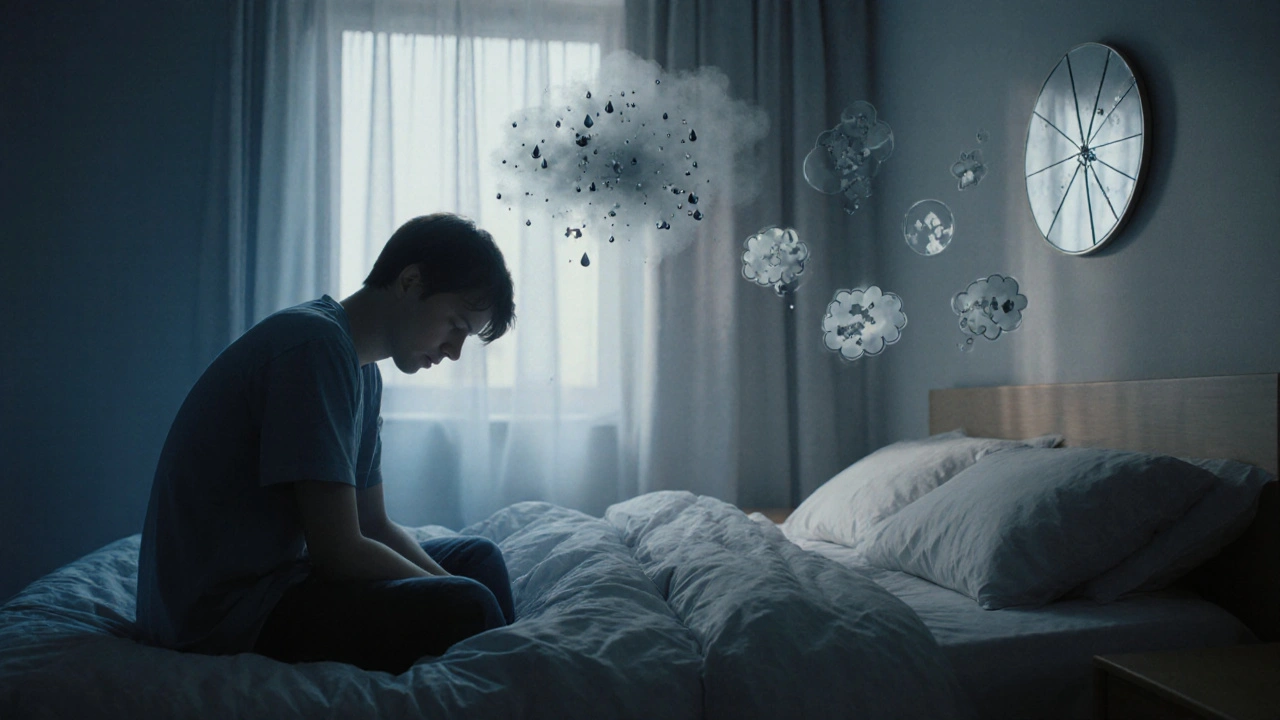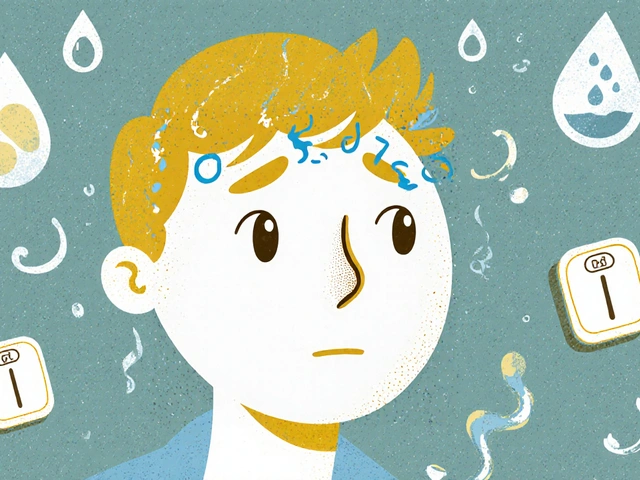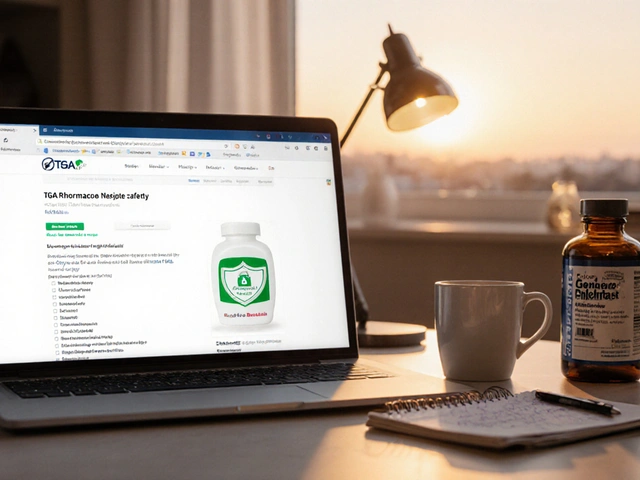Quick Takeaways
- Depression shows up as emotional, cognitive, physical and behavioral changes.
- Symptoms must persist for at least two weeks and interfere with daily life to be concerning.
- Common signs include persistent sadness, loss of interest, sleep problems, appetite shifts, fatigue, and thoughts of self‑harm.
- Professional help-therapy, medication, or a combination-works for most people.
- Early self‑assessment and support from friends or family improve recovery odds.
What Is Depression?
When we talk about Depression is a mental health condition marked by persistent low mood, loss of pleasure in activities, and a mix of physical and emotional symptoms. It’s not just feeling sad after a bad day; it’s a longer‑lasting state that can reshape how the brain processes emotions, thoughts, and bodily signals.
Clinicians often label the clinical form as Major Depressive Disorder (MDD). The diagnosis follows criteria from the DSM‑5, which require at least five symptoms, including either depressed mood or loss of interest, lasting two weeks or more.
Core Symptom Categories
Symptoms cluster into four buckets. Understanding the categories helps you spot patterns that might otherwise seem unrelated.
- Emotional: persistent sadness, hopelessness, irritability.
- Cognitive: difficulty concentrating, indecisiveness, negative self‑talk.
- Physical: changes in sleep, appetite, energy, and pain.
- Behavioral: withdrawal, reduced activity, neglect of responsibilities.

Detailed Symptom List
Below is a deeper look at each symptom type, with real‑world examples you might recognize.
Emotional Signs
- Feeling empty or numb most of the day.
- Overwhelming guilt over small mistakes.
- Sudden bursts of irritability, even over trivial matters.
Cognitive Signs
- Brain fog that makes simple tasks feel like puzzles.
- Repeating the same negative thoughts, such as "I'm a failure," without relief.
- Indecision that stalls everyday choices like what to eat.
Physical Signs
Physical changes often get overlooked because they can mimic other health issues.
- Sleep disturbances (insomnia or hypersomnia)-you might lie awake for hours or sleep 12hours and still feel exhausted.
- Appetite changes (significant weight loss or gain)-sometimes food loses its appeal, other times cravings become intense.
- Fatigue (persistent low energy despite rest) that makes climbing stairs feel like a marathon.
- Unexplained aches, headaches, or digestive upset without a clear medical cause.
Behavioral Signs
- Withdrawing from friends, family, or hobbies you once loved.
- Neglecting work, school, or household responsibilities.
- Increased use of alcohol or other substances to numb feelings.
One of the most alarming signs is recurring suicidal thoughts (thoughts about self‑harm or ending one's life). Even fleeting ideas deserve immediate professional attention.
When Symptoms Signal a Problem
Not every low mood qualifies as depression. Clinicians look for two key thresholds:
- Duration - symptoms persisting for at least two weeks without significant relief.
- Impact - interference with work, relationships, or self‑care.
If you notice a combination of symptoms meeting both criteria, it’s time to act.

Common Misconceptions
Many people dismiss depression as "just being sad" or think "toughening up" will fix it. Reality check:
- Depression is a brain‑based condition, not a character flaw.
- It can affect anyone, regardless of age, gender, or socioeconomic status.
- Physical illness, hormonal shifts, chronic stress, and genetics all influence risk.
These myths delay help‑seeking and worsen outcomes.
How to Seek Help
Starting the conversation can feel daunting, but breaking it into steps makes it manageable.
- Self‑assessment - Use a reputable screening tool like the PHQ‑9. Score 10+ often indicates moderate depression.
- Talk to a trusted person - A friend, family member, or colleague can provide initial support.
- Contact a professional - General practitioners (GPs), psychologists, or psychiatrists can confirm diagnosis.
- Discuss treatment options - Cognitive Behavioral Therapy (CBT) and antidepressants (medications that balance neurotransmitters) are the most evidence‑based approaches.
In Australia, the Australian Department of Health offers a free helpline (131114) and online chat for immediate crisis support.

Managing Symptoms Day‑to‑Day
While professional treatment is essential, daily habits can lessen symptom severity.
- Sleep hygiene: Keep a consistent bedtime, dim lights an hour before sleep, and avoid caffeine after midday.
- Balanced nutrition: Aim for meals with protein, complex carbs, and omega‑3 rich foods like salmon.
- Movement: Even a 10‑minute walk releases endorphins and improves mood.
- Social connection: Schedule a brief call with a friend; isolation fuels negative thoughts.
- Mindfulness: Simple breathing exercises can curb rumination within minutes.
When symptoms feel overwhelming, a brief journal entry noting the trigger, emotion, and a coping action often reveals patterns you can address with a therapist.
Comparison of Emotional vs. Physical Symptoms
| Aspect | Emotional Symptoms | Physical Symptoms |
|---|---|---|
| Typical feeling | Persistent sadness, emptiness, hopelessness | Fatigue, low energy, aches |
| Thought patterns | Negative self‑talk, guilt, worthlessness | Difficulty concentrating, brain fog |
| Sleep impact | Insomnia due to racing thoughts | Hypersomnia or early‑morning awakening |
| Appetite | Loss of interest in food | Cravings for carbs or binge eating |
| Behavioral response | Social withdrawal | Reduced physical activity, staying in bed |
Frequently Asked Questions
How long must symptoms last before it’s considered depression?
Symptoms need to persist for at least two weeks and cause noticeable impairment in daily functioning.
Can depression appear without feeling sad?
Yes. Some people experience predominantly physical signs-fatigue, sleep problems, or pain-while emotional sadness is mild or absent.
What’s the difference between depression and normal stress?
Stress is usually linked to a specific trigger and subsides when the trigger resolves. Depression is a pervasive mood disorder that lingers beyond the original stressor.
Are antidepressants safe for everyone?
They’re generally safe, but doctors assess medical history, potential drug interactions, and side‑effect profiles before prescribing.
How quickly does therapy start to work?
Many people notice reduced distress after 4‑6 sessions of CBT, though full benefits often emerge over several months.
Can lifestyle changes replace medication?
For mild depression, regular exercise, sleep hygiene, and social support can be enough. Moderate to severe cases usually need professional treatment, often combining therapy and medication.
What should I do if I have suicidal thoughts?
Call emergency services (000 in Australia) or the Lifeline crisis line at 131114 immediately. Never wait for an appointment if you feel unsafe.
If you’ve recognized any of the depression symptoms listed here, remember you don’t have to navigate them alone. Reach out, get an assessment, and start the path toward feeling like yourself again.






Ben Poulson
October 7, 2025 AT 18:14It is commendable that the article delineates both emotional and somatic manifestations of depressive disorders with a level of precision that facilitates clinical comprehension; however, the inclusion of statistical prevalence data would augment its utility for epidemiological discourse.
Raghav Narayan
October 9, 2025 AT 06:21From a therapeutic perspective, the systematic categorisation of symptom clusters serves as an indispensable scaffold for both assessment and intervention planning, enabling clinicians to triangulate patient-reported experiences with observable behavioural patterns; moreover, the nuanced discussion of neurobiological underpinnings underscores the importance of biopsychosocial integration in treatment paradigms. The article aptly highlights the chronicity criterion of two weeks, which aligns with DSM‑5 specifications, thereby reinforcing diagnostic validity. It also correctly identifies that depressive symptomatology may present predominantly through somatic channels, a fact often overlooked in primary care settings. The emphasis on self‑assessment tools such as the PHQ‑9 is particularly valuable, as it empowers individuals to engage in preliminary screening before seeking professional input. Additionally, the suggested lifestyle modifications-sleep hygiene, balanced nutrition, and regular movement-reflect evidence‑based adjunctive strategies that can potentiate pharmacological and psychotherapeutic outcomes. The inclusion of Australian-specific resources demonstrates cultural sensitivity, though analogous references for other regions would broaden relevance. Importantly, the article does not neglect the critical issue of suicidality, urging immediate crisis intervention, which is a non‑negotiable safety imperative. While the structure is methodical, integrating case vignettes could facilitate reader empathy and comprehension. Overall, the guide furnishes a comprehensive yet accessible overview that can serve both laypersons and mental‑health professionals alike.
Tara Phillips
October 10, 2025 AT 18:28Great rundown of the basics.
Benjamin Herod
October 12, 2025 AT 06:34Honestly, after reading the “quick takeaways,” I felt like I was being handed a checklist for my own misery; the tone is so clinically detached that it almost feels like the author is trying to numb us with jargon while simultaneously handing us a life‑saver.
luemba leonardo brás kali
October 13, 2025 AT 18:41While the breakdown is useful, a note on cultural variations in symptom expression would have enriched the piece; in many African contexts, somatic complaints often dominate the presentation, and without that lens the guide risks feeling Western‑centric.
Corey McGhie
October 15, 2025 AT 06:48Appreciate the thoroughness, but let’s be real: not everyone can afford therapy, so the emphasis on cheap, evidence‑based habits like a 10‑minute walk or a proper sleep schedule is the real hero here-cheers for keeping it practical.
Ajayi samson
October 16, 2025 AT 18:54Practical? Please. The article pretends that a stroll in the park is a cure‑all while ignoring systemic barriers like lack of safe spaces, food insecurity, and the sheer cost of medication. Nice vibe, wrong vibe.
Lief Larson
October 18, 2025 AT 07:01great guide lets people know what to look for
Julia Grace
October 19, 2025 AT 19:08Love the rainbow of language you used-“brain fog” and “unexplained aches” paint a vivid picture that anyone can relate to; it’s refreshing to see medical info wrapped in everyday words rather than a sterile monologue.
Sadie Bell
October 21, 2025 AT 07:14Exactly, the way you framed the symptoms makes it feel less like a lecture and more like a friend sharing what they’re going through, which can lower the stigma barrier for many.
Noah Bentley
October 22, 2025 AT 19:21Okay, but why does the article keep using the term “mental health condition” like it’s a brand name? Just say depression and move on, we get it.
Kathryn Jabek
October 24, 2025 AT 07:28In contemplating the ontological dimensions of affective dysregulation, one must acknowledge that the phenomenology of depression transcends mere symptom enumeration, beckoning a dialectic between existential dread and the quotidian erosion of agency.
Emily Wang
October 25, 2025 AT 19:34True, the existential weight you mention can feel crushing, yet grounding techniques-like the breathing exercise you hinted at-offer a tangible foothold amidst that abstract despair.
Hayden Kuhtze
October 27, 2025 AT 07:41Oh brilliant, another checklist of “do this, feel better,” as if depression were a simple to‑do list. Spoiler: it’s not.
Craig Hoffman
October 28, 2025 AT 19:48Hey, the guide’s info is solid and the tone is chill-not too preachy-so kudos for keeping it real and reachable.
Jessica Wheeler
October 30, 2025 AT 07:54While the article is generally well‑structured, it would benefit from citing peer‑reviewed sources to substantiate the claims made, thereby enhancing its credibility.
Mikayla Blum
October 31, 2025 AT 20:01Reading through the symptom matrix feels like peeking into a diagnostic mirror; it’s fascinating how the same neural circuitry can manifest as either sleepless nights or relentless fatigue.
Jo D
November 2, 2025 AT 08:08Sure, “fascinating,” but let’s not romanticise neurobiology when people are drowning in real‑world pain; the guide’s optimism can sometimes gloss over the brutal reality of access issues.
Sinead McArdle
November 3, 2025 AT 20:14I appreciate the measured tone; the information is presented without sensationalism.
Katherine Krucker Merkle
November 5, 2025 AT 08:21Indeed, the restraint in language makes it a trustworthy reference point for those seeking clarity without feeling judged.